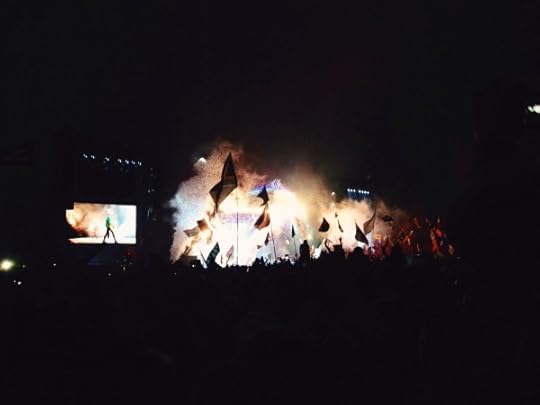Matador Network's Blog, page 2300
March 14, 2014
Powder for Powder, episode 5
AFTER SIX WEEKS ON THE ROAD in Alaska, finally heading south felt good. Yancy and I left Arctic Man wiped out and frozen from a week of below-zero days and Stouffer’s bagged stir-frys. We had planned our last stop in Haines before we left home, but had been holding our breath for the stars to actually align. We’d heard from friends about the “knife fight” at the heli-pad, but a call from fellow Matador Ambassador Will Wissman with Stellar Media confirmed they were still holding spots for us.
Haines is arguably the best place in the world for heli-skiing. I’ve been there four out of the past five spring seasons and each year somehow seem to score the best runs of my life while enjoying the relaxed small town atmosphere by the sea. Haines is a fishing town that has a certain mountain energy and vibrancy. Most of the town welcomes the heli community and acknowledges the business it brings to the harbor, which was recently cut off as a cruise ship stop during the economic recession.
I was most fired up this year to share the experience with my brother and live vicariously through his first time getting “towed in” to fragile cornices and steep spine walls. After a weeklong storm, we lucked into a code blue scenario with a relatively stable snowpack, just in time for the last and best weeks of the heli season. We lifted at 6am, and immediately it was go time as our guide, Reggie Crist, and cameraman, Will Wissman, proposed a challenging first line. The zone called Dick’s Picks demands a rider to remember exactly where he’s going because of natural blind rollovers on the face, a very common Alaskan terrain issue and one you don’t want to get wrong. I didn’t doubt for a second that Yancy would step up and slay a nasty line choice with style and confidence. He did just that with first drop, and his first ever filmed Alaskan line. The session was on!
For the next two days we bounced around the mountaintops, picking off lines we identified as aesthetic, difficult, and inspiring to watch on film. Yancy felt right at home copping some serious airtime with every line. We couldn’t have had a better time together riding big mountain lines in perfect blower powder conditions, not to mention getting all the action filmed from the air. Truly unforgettable times were had exploring the Southeast section of the Chugach Mountain Range. A huge thanks to SEABA Heli and the production team at Stellar Media.
Haines is on every powder hound’s bucket list for good reason, and Yancy was ecstatic to check this one off. Leaving Alaska, we headed back down the five-day dusty trail to Idaho and felt like we’d just conquered the world. A two-month, 6,500-mile road trip was coming to a close, and somehow we had pulled it off without any major incidents along the way. The trip, which we’d questioned at first with the snowboarder’s cardinal rule in mind — “Thou shalt not leave powder for powder” — turned out to be a wild adventure and well worth the effort. After all, “the pow is always deeper on the other side…” 
Words and photos by Wyatt Caldwell and Will Wissman; video by Yancy Caldwell.

1
Tony Pavlantos gets barreled on an unnamed zone in Glacier Bay National Park. This is what an afternoon with Fly Drake can get you, if you have capable crewmen like Tony P.

2
Yancy crushed his first legitimate heli-powered Alaskan line. A Chugach classic, Dick’s Picks, which I rode four years ago.

3
Here I am battling my way down a prominent spine on a super gusty day. The wind made for some incredible images of sluff spiraling into the air.
Intermission

Powder for Powder, ep. 2: ALCAN adventure

Powder for Powder, ep. 4: Arctic Man

Powder days on the Gaspé Peninsula, Quebec [pics]

4
Yancy keeps his speed up as he traverses above a cliff band he plans to launch.

5
Looking across at a face called FFAA as I prepare to rip one of the most photogenic lines of my life.

6
A bit intimidating to drop your line when this is what you see looking out. Stellar Heli in full effect.

7
The heli pulled a full rotation around FFAA on this run, giving my line a very unique cinematic aspect.

8
A different angle shows Stellar cameramen Will Wissman and Jeff Loewe getting the shot of Yancy plastering down an FFAA approved spine.

9
POV of an evening line down a face called Samson and Delilah. I advised Yancy via radio not to pop off the nipple near the top. He did not listen and instead landed himself a 2-page spread.
Intermission

Powder for Powder: A winter pilgrimage from Idaho to Alaska

Snowboarder Jonaven Moore sets his sights on human-powered mountain access.

Snowboard the most beautiful spots on earth…in HD

10
A quick snap of the Caldwell bros after a successful session in the mango chutney evening light.

11
The SEABA Heli staff and guides soak up the last sun rays of the heli season before parting ways for the summer.

12
Celebrating the last day of heli season in Haines with a cast of characters at the mouth of the Chilkat River.
The post Powder for Powder, ep. 5: Heli-skiing Haines, Alaska appeared first on Matador Network.

How to piss off an introvert

Photo: Toffee Maky
The characteristics associated with ‘good travelers’ are usually those attributed to the extrovert. Someone who is high energy, willing to talk to anyone, anywhere, for any length of time. The sort of person who can spend five minutes with someone and walk away with a friend for life. A ‘people person.’
But introverts travel, too. We struggle with small talk and social exhaustion, feeling guilty that we’d rather have a quiet dinner alone than explore Berlin’s nightlife scene. We struggle against our extroverted counterparts, the outgoing, talkative travelers who are always trying to drag us out and convince us we’re missing out on life because we’re not living it exactly as they do. And while we appreciate the energy and stream-of-consciousness commentary extroverts provide, sometimes we really just wish they’d let us keep to ourselves instead of pushing every single one of our buttons.
Ask why we’re so shy.
The biggest misconception about introverts is that we’re shy or anti-social. We don’t necessarily suffer from social anxiety. We just find small talk tedious and fighting to be heard in a crowd exhausting. Because of this, we get pegged as aloof, reserved, or rude. Where extroverts thrive on the energy of other people, introverts often feel drained by it. The group dynamics and the incessant talking, while enjoyable in small doses, can quickly become overwhelming.
Take our need for alone time personally.
We need to be alone. Get over it. Our need for quiet time to decompress and process the events of the day has nothing to do with you. It doesn’t mean we don’t like you, it doesn’t mean we don’t ever want to be around you, and it doesn’t mean we’re mad. It just means we want to be alone for a little bit. So if we insist on going for a long walk or grabbing a cappuccino alone or putting on our headphones while riding the train, please just let us go. And don’t take it personally.
Ask if we’re mad.
WE’RE NOT MAD.
Be clingy.
Introverts need extra space. We circle carefully around new relationships, particularly new travel relationships, before committing to anything and are reluctant to travel with others who don’t understand or respect our need for quiet time to recharge. If we act a little noncommittal about a spontaneous week-long trek in Tasmania, it’s probably because we’re still weighing out how likely you are to talk incessantly or be offended by our need to be alone.
Talk incessantly.
We’re not always capable of tuning other people out and are prone to feeling smothered by the extrovert’s need to talk every little detail through. We may really, really like you, but sometimes we just wish you’d stop talking for a few minutes so we can think.
Tell us we need to learn to speak up.
We are not shy. We are only turned inward, processing things slowly and deliberately. When we have something to say, we’ll say it. The best way to guarantee silence from an introvert is to push them to speak. We’ll talk when we’re ready to talk. Pressuring us to speak and putting us on the spot only succeeds in making us so uncomfortable that we don’t want to speak at all.
Push us into commitments.
Introverts need an emergency exit for every social situation. We need to know that if we become completely overcome with social fatigue at 10pm in the middle of a nightclub and need to get out immediately, we can. Because of this we can be a little reluctant to commit to a situation where we might get trapped. The prospect of not being able to leave exactly when we’re ready to go is enough to make us want to stay home.
Tell us we’re missing out on life.
Just because we prefer a different type of travel, a different type of experience, doesn’t mean we’re missing out on life. We’re not much for clubbing or staying out till 2am screaming drunk with a bunch of strangers, and we’ll never be the sort of traveler to become best friends with the shopkeeper we just met, but we’re observant and studious, soaking in quiet mornings and watching towns come to life. We find the best cafes and keep meticulous trip notes, and just because we’re not gushing about how much we love Paris doesn’t mean we love Paris any less than you.
Put us on the spot.
Hand us a microphone in a karaoke bar, pull us up on stage, insist we stand up and dance. We’re happy to cheer you on, but despite what you may think, we aren’t secretly wishing to be up on stage and we don’t want you to drag us up there. It’s not that we won’t belt out a tune in public or give a wildly witty toast at a party, it’s just that we don’t like to get thrown into things without warning.
Tell us to cheer up or stop being so serious.
We’re thinkers, processors, people who thrive on reflection. An introvert sitting quietly alone is not necessarily angry, depressed, or completely incapable of laughing. We’re just thinking. Please stop asking us what’s wrong and suggesting that maybe we should talk to someone about it. We’re fine. Really.
Tell us we need to come out of our shell.
After social interactions and group settings, introverts need to retreat to their shells. We need to be alone and we need down time. This isn’t a sign of depression or social anxiety. It’s just how we function. The best thing you can do after dragging an introvert to a party is to give us time to withdraw and re-energize. Happy introverts are those who find friends (and travel partners) willing to give us this space, knowing that this is just part of how we process the world and the people in it. [image error]
The post How to piss off an introvert appeared first on Matador Network.

March 13, 2014
Sharks vs. humans [infographic]
THE PUBLIC PERCEPTION OF SHARKS as “killing machines” is straight up ludicrous, and mostly comes from the fact that sharks are awesome horror movie monsters. I’ll admit, I like movies like Jaws, Sharknado, and Sharktopus just as much as the next guy, but the misconceptions they breed are definitely problematic. While sharks are by no means harmless, their image as mindless killers is wildly exaggerated, especially when you consider how much we kill them.
It’s staggering. Check out the incredible infographic by Joe Chernov and Robin Richards below — note that the number of humans killed by sharks is listed per year, while the number of sharks killed by humans is listed per hour.
“Finning” is the totally unsustainable (and cruel) practice of catching sharks, cutting off their fins, and dumping the animals back into the ocean to die. The fins are used for “shark fin soup,” which, incidentally, you should never eat, given the endangered status of these sharks.
To learn more, here are links to Shark Conservation Society, Stop Shark Finning, Humane Society International, Pew Environment, and Sharkwater.
The post Stunning infographic shows who kills who in the battle of sharks vs. humans appeared first on Matador Network.
On Seoul's growing Muslim community

Original image: Kian
An afternoon prayer call sounding from the Central Seoul Mosque drowns out the ambient blare of storefront K-Pop and shouts of taxi drivers as Seoulite Muslims scale the steep cobblestone path to gather together in worship.
The cookie-cutter framework of modern urban Korean architecture gives way all at once to colossal columns and arches that hover impressively over Itaewon, the neighborhood itself a testament to the contained, yet explosive expansion of multiculturalism in Korea in recent years. Other prominent cultural communities of the area are largely based on parameters like ethnicity and language, while the Muslim community of Seoul is diverse in and of itself, creating a very small but dynamic subculture decorated with influence spanning dozens of countries, evident among the array of faces, languages, and accents layered beneath the uniform hijabs and prayer sets.
Islam only began to have any significant presence in Korea toward the late 1990s, largely due to immigration restrictions loosening at that time. Today, the majority of Muslims in Korea are students, teachers, and migrant workers, and only a fraction of Korea’s 135,000 Muslims are native to Korea, roughly 30,000-35,000 people — a figure that hasn’t risen drastically in the last 30 years.
Curiosity is a simple yet major factor in the number of Koreans converting to the religion.
“I had no exposure to Islam until a few years ago, but it created a curiosity in me,” one recently converted Korean said. “I began to study and become more dedicated, and realized there is a community of Koreans who practice Islam.”
Dyas Reda Kenawy is an Indonesian woman earning her PhD in Korean Culture and Language, and she says that this curiosity is a simple yet major factor in the number of Koreans converting to the religion. “Some Koreans are bored with life without religion. Modern Koreans don’t really have a strong link to religion. So they begin to explore new religions online, and for some, it leads them to our mosque.”
The Korean convert admits that it’s a huge decision in Korean society to convert to something so unfamiliar, noting that any true growth of Islam in this country will likely continue to be a result of immigration to the heavily Buddhist, Christian, or otherwise agnostic nation.
“As a Korean, I can say I think we don’t particularly try and understand other cultures,” he said. “My curiosity is uncommon.”
His observation may be narrow, however. As you walk through the grounds of the Seoul Mosque, Korean tourists buzz around every corner, cameras slung over their shoulders. Kids litter the steps that sweep up to the prayer hall itself, sliding down the handrails and chasing after one another through groups of girls posing for the perfectly executed photo in front of the impressive backdrop. Lifelong Seoulites line up for a tour group, gazing up at the domes above.
“I don’t know anything about Islam, we just never have been to the mosque, and it’s very beautiful. I’m curious now,” one local said as she rushed off to join a tour group. Other Korean visitors proudly called the mosque one of Seoul’s “hidden gems.”
Kamal Singh, an Itaewon local since 2009, said the Muslim community doesn’t really see any problems other cultural groups wouldn’t face in a foreign city. He said that to an extent, one doesn’t just immigrate to Seoul without the expectations of some cultural barriers and inconveniences.
“In the years I’ve been in Seoul, I’ve come to this same halal shop, but many, many more have come up, along with restaurants and shops catering to Muslims, and the area is busier than ever,” he said. “The community itself is growing slowly and steadily, but also smoothly because the purpose of Islam is to spread peace, and the Koreans here are receptive to that. It makes for an interesting time to live here, to see the growth of a cultural identity.”
Any discrimination or persecution is ideologically driven, and highly targeted. The Korean convert specifically asked not to be mentioned by name because according to him, there have been several recent incidents during which members of Christian extremist groups have interviewed worshippers at the mosque and used responses out of context “to slander” the Seoul Muslim community. The atmosphere is suspicious, and many worshippers are now wary of visitors to the mosque.
This sort of negative propagation is incredibly damaging to a community that already experiences heavy misperception from Koreans. Professor Hee Soo Lee, in the Department of Cultural Anthropology at Hanyang University, claims that Koreans lack a basic understanding of Islam, and actions like those of the Christian extremist groups are major catalysts that contribute to what he calls “Islamophobia,” especially in the absence of qualified manpower to propagate the Islamic message properly: “[There is] ignorance of Islam among Koreans due to distorted information,” Professor Lee said. “Furthermore, negative ‘image-making’ by the radical Christian groups and media of the West.”
Several students have had similar experiences. “From the very first year I’ve lived in Korea, extremist missionaries will knock at my door,” said Medihah, a Malaysian student at Hanyang University. “At first, they ask very simple questions, but then suddenly they’ll become very aggressive and try and debate with me, get me to say something I don’t mean — it’s very disturbing.”
The community has actively sought to bridge this cultural disparity, with significant help and support from local embassies and offices within the Korean government itself. Shaukat Ali Mukadam, the Pakistani ambassador to Korea, said that the embassy hosts a number of cultural events throughout the year, including photographic exhibits and festivals, to encourage more intermixing and dialogue.
“Korean society has transformed in the last 50 years,” Mukadam said. “There’s been rapid development in multiculturalism, but we still don’t have that direct line of communication [with the Korean community].”
Korea is a country where everything changes fast and adjustments are made for the better.
Representatives from the Malaysian embassy agree, but believe this relationship will develop. “There has been a gradual increase [in Muslim immigrants] over the years as Korea’s ‘hallyu’ has made outsiders more aware of Korea and its attributes,” said Sulochana K. Indran, a representative from the embassy. “The increasing number of foreign nationals entering the homogenous Korean society will of course pose challenges to both the foreigners and Koreans alike, but Koreans seem to be taking this inevitable globalization in their stride.”
Ambassador Mukadam also said that the Korean government is extremely sensitive to its growing foreign communities, and often assists the embassy in promoting cultural diffusion, a pledge that is controversial among many Koreans because of the budget allocated toward the endeavors, according to Hassan Abdou, founder of the Facebook community Arabs and Egyptians in Korea.
Abdou said that he resented the misperception of Islam among Koreans at first, but now he understands it. “[Koreans] only have the ideas the Western media gave them about Islam,” he said.
Korea itself only entered the global conversation in recent years, after all. Before Abdou moved to Korea, there was no K-Pop wave or K-drama craze. All he knew about the country was that his LG television in Egypt was made in Korea — but eight years later he calls Korea home, along with nearly 135,000 other Muslims.
Medihah and her friend Fadilhah, also a Malaysian student, both agreed their expectations of life in Korea paled to the reality. Before immigrating, they had both assumed they’d be less religious while living in a culture with so little Islam. “The surroundings and people — getting to know friends from other countries that are also Muslim — has made me a stronger Muslim, actually gotten me more interested in the religion,” Medihah said.
And walking up “Muslim Street,” it’s evident that this area is unique, Islam influence aside. Dotting the alley are Turkish kebab shops with their infamous ice cream servers entertaining passersby out front, Indian restaurants that fill the street with an aromatic swell of curry, bookshops boasting titles with languages from an array of Muslim countries, and Pakistani stalls showcasing gorgeous garments and shawls.
Dyas’s husband, in addition to his own travel agency, operates an Indonesian restaurant, Siti Sarah, decorated within by artwork from Egypt and other Islamic countries. A nod to his wife’s heritage, the restaurant was actually opened before the two of them had even met. “We laugh about it,” Dyas said. “He says that maybe God prepared it for [me].”
However, this intermixing of cultures that share the Islamic bond is uncommon in Seoul, and can actually be a hurdle to the growth of the Muslim community, according to Professor Hee Soo Lee. She claims that since the immigrants themselves often hail from largely homogeneously ethnic societies, they are less apt to thrive in communities of mixed nationalities. But it’s an obstacle immigrants like Dyas and her husband and Medihah and her friends are embracing and overcoming.
“Even five years ago Koreans still saw me as strange. But in Seoul the people have grown so much more open-minded.”
Sarah Hassan, who completed her graduate and postgraduate studies in Korea from 2002 to 2008, said that Islamic immigrants can thrive in Korea because it’s a country where everything changes fast and adjustments are made for the better. “Things are moving at a fast pace here in all spheres of life,” she said.
Hassan said that when she first moved to Seoul in 2002, she had to suspend her law studies since there was not a single program offered in English. Now, with the explosion of foreign students, from 7,000 in 2002 to more than 113,000 in Seoul in 2012, university offerings are more extensive than ever. Even the more trivial things that were incredibly difficult in 2002, like finding yogurt and cheese, are commonplace now.
Hassan, originally from Pakistan, said one of the more important aspects of Korea is that it is “very, very safe” for women. “It is safer than any Muslim country,” she said. “I’ve lived here without any fear that I would otherwise have to deal with back home.”
According to Dyas, the rapid growth of the community in Itaewon has created a stronger sense of religion for many Muslims. Even in the last five years, there are far more shops and the Islamic corner of Itaewon is busier than ever. “Even five years ago [Koreans] still saw me as strange,” Dyas said. “But in Seoul the people have grown so much more open-minded.”
Dyas has also lived in Gwangju, where the Islamic presence is slowly growing, and Busan, where there are many Indonesian migrant workers, attributed to a swelling influence.
The sheer growth of Islam in Itaewon is quantifiable, too. Dyas’s husband, a local business owner from Egypt, owns a travel agency licensed by the King of Saudi Arabia and the government to arrange the Islamic pilgrimage to Mecca, or Hajj. The number of Muslims permitted to take the pilgrimage is set by the government each year, and that number is dependent on the percentage of a country’s population that is Muslim. For a country like Indonesia, 250,000 Muslims are granted visas to visit Mecca, whereas in Korea the number stands at around 150. The interest for Hajj is about 375% over capacity, however.
“It’s a healthy sign of growth for us,” Dyas said.
Dyas said that most of the challenges associated with practicing Islam in Korea come from a lack of awareness about Islamic customs among Koreans. For example, keeping to the prayer schedule traditional to the Muslim religion can be a challenge. In places like Indonesia, there are a lot of smaller mosques to help Muslims work in their prayer rituals around the pace of their 21st-century lifestyles. With just one mosque in Seoul, most Korean companies aren’t very sensitive to the prayer practice.
Medihah and her friends agreed, adding that the main outward aggravation they routinely experience is directed at their headscarves, or hijabs, attire entirely unfamiliar to Koreans. “We get a lot of people staring and asking why we wear it,” Medihah said, laughing. “It’s mostly just ajumas asking us if it’s too hot, and suggesting that we take it off.”
Koreans are beginning to understand Islam, however, according to Dyas. For years the media in Korea heavily portrayed it as a “terror religion,” but the perception has shifted. “Lots of the Koreans that live in Itaewon will address the Muslims they meet as ‘sister’ and ‘brother’ [which is a part of Islamic tradition],” Dyas said.
In this way, the impact of Islam is outpacing the population growth. A. Rahman Lee, Ju-Hwa, Imam of Seoul Central Mosque, said that 9/11 actually greatly affected Korea in two ways. “At first, it was difficult because many understood Islam to be a terror religion,” he said. “But it also sparked a curiosity, a conversation.”
He said that Islam hadn’t spread much to Korea because it simply wasn’t on the radar; there was little knowledge of it at all. Professor Lee Hee-Soo agreed, saying that post-9/11 many Korean people did try and understand the Islamic world, and tried to do so through a balanced platform, not necessarily relying on Western media.
“Korea is becoming an international power, with its citizens traveling more and foreigners integrating here,” A. Rahman Lee said. “So international events affect the country more and more.” 
The post On the growing Muslim community in Seoul appeared first on Matador Network.
I thought you knew humans could fly
THIS IS LESS like paragliding, or bungee jumping, and more like purring past cliff faces on a pod racer in Star Wars. The only difference is the fact that your chin is the outermost part of your vehicle, inches away from rock and earth.
Scotty Bob Morgan is what’s known as a “proximity wingsuit flyer,” which is basically someone who has unbelievable levels of skill and judgement, and a nonchalant attitude towards the afterlife. This is a selection of what his flights across the U.S. looked like last year, as he tried to get as close to anything life-threatening as humanly possible.
It’s insane. 

The post I thought you knew humans could fly appeared first on Matador Network.
Help kids and crush stuff in a tank
YOU HAVE until tomorrow (March 14, 2014) midnight to enter for a chance to fly to LA, meet Arnold Schwarzenegger, and crush things in his tank. This is a fundraiser for the After School All-Stars, a nation-wide program that looks to empower youth for a better chance at positive futures.
One entry costs $10, but you can buy entries in bulk and get discounts. Every dollar donated will be matched by Ahnold himself. To enter, click here.
If I went, I’d request to crush poverty. What would you crush? 
The post Crush things in a tank with Arnold Schwarzenegger and help America’s kids appeared first on Matador Network.
7 places gringos love in Brazil

Photo: Casa Fora do Eixo Minas
This one goes out to art lovers everywhere. Imagine a private property set within mountains, ornamented with exquisite plants and some of the most dramatic visual installations you’ve seen. Welcome to Instituto Inhotim.
A first-time visitor should take at least two days to see it all. The biggest outdoor center of arts in Latin America, Inhotim is an immense botanical garden holding ~500 pieces produced by Brazilian and international artists spread over a property comprising 3,000 acres. Some are big names, such as Dan Graham and Hélio Oiticica. My favorite piece is this mirror glass structure hidden inside the woods.
The place is super organized, the ticket price isn’t outrageous, and there are lodging options for every budget. As Brazilians so often say: “It doesn’t even feel like we’re in Brazil!” #risos
2. Iguazu Falls (Paraná)

Photo: markg6
Iguazu Falls, located at the border intersection of Brazil / Argentina / Paraguay, puts Niagara to shame, with a total width of 2.7km.
Only Victoria Falls can beat Iguazu in quantitative metrics, but while the South American site divides itself into smaller falls and allows for views from several angles, Victoria is an overwhelming wall of water that needs a helicopter to be fully appreciated. If you dig this sort of comparison, check this article.
Iguazu sits inside a national park, filled with tourists all year round. There are boardwalks over the water, lots of animals to see (beware of the small mammals called quatis — they’re everywhere and tend to steal snacks, hats, cameras, and pretty much everything you make available), boats to get closer to the falls themselves, and all sorts of organized tours. (Note: Views are better from the Argentinian side.)
3. Fernando de Noronha

Photo: Henrique Vicente
This archipelago is home to some of the most beautiful beaches in a country with plentiful beautiful beaches. There’s a strict cap on the number and duration of visits, and professional guides are required for all swimming and diving. It’s quite a trek from the mainland, with flights leaving from the northeast cities of Recife and Natal.
There are posadas and hotels available, but they must be booked in advance and respect the island’s population limit. When considering plane tickets, hotel fees, guided tour fees, and food costs, it becomes clear that this is no cheap vacation. To say that’s the reason why Noronha is being so well cared for can’t be proved, but one thing is for certain: No one wins if scenery like this is lost.
4. Jericoacoara (Ceará)

Photo: ground.zero
The story goes it was in the late ’90s that a famous travel guide named Jericoacoara “one of the top 10 beaches in the world.” That was enough to bring local and foreign tourists stampeding onto the vast sand dunes that once separated Jeri from the rest of the world.
It’s easy to understand what must have struck the guidebook author about the place. I can almost see him eating fresh oysters washed down with cold beer, watching small fishing boats traversing the waves, while enjoying the unceasing breeze with both feet planted on the seashore. But truth be told: This is not even one of the most beautiful beaches on the Brazilian coast. Especially not now that tourism has run amok. Think expensive tours, teen prostitution, and a place called Planet Jeri (as in Planet Hollywood, but worse).
5. The Amazon

Photo: lubasi
The Amazon region extends into Peru, the Guianas, Ecuador, Colombia, and Bolivia. But it’s become synonymous with the enormous Amazonas state in the northwest part of Brazil. That’s where you’ll find the city of Manaus, with its old theater (did you know Jack White got married there? true story!) and famous tacacá soup.
It’s possible to visit the area on a budget, but the Amazon is no easy terrain to access — hence the rise of the high-end eco-resort. Since going on your own outside the defined perimeters is only for the brave (it’s a jungle out there, and a humid, mosquito-filled one), tourists who stick to the program will find several options for boat rides, tribe visiting, and animal-watching excursions.
What the Amazon lacks in practical visiting, it compensates for with a feeling of sublimity you won’t get many other places. It’s a rich, thick, luscious environment, fragile and strong at the same time.
6. Rio

Photo: Gustavo Valentim
There are several reasons why gringos are crazy about Rio, and it’s easy to agree with them. Arpoador, Cristo Redentor, Pão de Açucar, the bars, the people, the most exuberant Carnival parade on Earth.
And then you have the trashy hostels, abundant sexual tourism, favela tours, cheap cocaine, and that intense, anything-goes vibe. Rio has it all and is one of the most beautiful cities in the world, hands down.
7. The Pantanal

Photo: Nori Almeida
This is a place for photographic safaris, colorful sunsets, amazing food, and an honest sense of being immersed in a vivid culture. Pantanal (pântano is Portuguese for “swamp”) became a popular destination back in the 1980s, after a local soap opera set in the region got national attention. The region is set up for tourists, with good transportation and super comfortable fazendas that take care of everything you need, whether it’s a matter of spending the day fishing, riding horses, or lying in a hammock.
Near the Pantanal, you’ll also find the touristic hot spot of Bonito (translates to “beautiful”), where transparent waters full of fish attract local families. Like Noronha, this is a controlled touristic environment, with visitor limits and guided-only walks. Gorgeous indeed. 
The post 7 places gringos love to visit in Brazil (and why they’re mostly right on) appeared first on Matador Network.
Věra Chytilová dies, aged 85
MY RELATIONSHIP WITH Czech film began when I lived in Prague in 2008; I had a non-traditional academic program that was experiential, rather than based on lectures, and was arts-immersive. One component consisted of private film screenings at Kino MAT. It was there where I saw Sedmikrásky (Daisies), for the first time.
The film was unlike anything I’d ever seen. The filmmaker, Věra Chytilová, was ahead of her time, and an integral figure in Czech New Wave Cinema of the 1960s. Daisies, which debuted in 1966 (just two years before the Prague Spring of 1968), was an absurdist social commentary against the Communist government. It was banned within the country immediately, but received media acclaim internationally. Věra directed over twenty five films in her lifetime.
It’s amazing that I have lived alongside people who were part of cultural revolutions, and that I am able to honor their lives once they pass. Maybe you’ve never heard of Věra, but maybe today is the day where you watch a few clips of her work on YouTube, or read her page on IMDB, and learn something new. 
The post Avant-garde Czech film director Věra Chytilová dies, aged 85 appeared first on Matador Network.
Around the world: 10 music festivals
Music festivals worldwide are similar: loud music, bad food, long lines, kids walking around in groups and varying levels of sobriety. Not to mention your legs giving up after the fourth gig in a row. What makes a difference is the location. Think mountain resorts in Japan, F1 racetracks in São Paulo, a hot spring in Iceland.
The international music festival season starts in late March with Lollapalooza Chile. With hundireds of events taking place around the world, here are 10 of the best.
1. Lollapalooza Brasil

Photo: Douglas Arruda
Where/when: São Paulo, Brazil / April 5 to 6, 2014
Who’s playing: Arcade Fire, Nine Inch Nails, Pixies, Phoenix, New Order, Vampire Weekend, Savages, Julian Casablancas, Vespas Mandarinas, Nação Zumbi
Lollapalooza landed in Brazil in 2012 and established itself as São Paulo’s main music event. In 2013, the festival will try a new location: Interlagos racetrack, where São Paulo Formula 1 GP happens. Pretty far from the city center, but there is easy access by train.
2. Moogfest

Photo: Jeff Gunn
Where/when: Asheville, NC, USA / April 23 to 27, 2014
Who’s playing: Kraftwerk, Chic with Nile Rodgers, Giorgio Moroder, Pet Shop Boys, Moderat, Daedalus, Mark Farina, Tiga
Created in New York in 2004, Moogfest moved to Asheville in 2010. This is the city where Moog’s synthesizer creator Robert Moog spent the last 30 years of his life. There are dozens of DJs and electronic live acts, workshops, lectures, and music label showcases.
3. Pitchfork Music Festival

Photo: Incase
Where/when: Chicago, IL, USA / July 18 to 20, 2014
Who’s playing: Beck, Grimes, Neutral Milk Hotel, Slowdive, Sharon Van Etten, Wild Beasts, Death Grips, Tune Yards, DIIV
The indie webzine turned most influential music website in the world is also successful IRL. It started inside Barcelona’s Primavera Sound and now exports the format to Paris every November. The Chicagoan edition is sort of a hipster playground, but the lineup is always interesting, fresh, and eclectic. Beware of the intense heat waves and go for it.
4. Mutek/Elektra: UM15

Photo: Semiconductor Films
Where/when: Montreal, Canada / May 27 to June 1, 2014
Who’s playing: Nicolas Jaar presents From Scratch, Audion, Move D. Full lineup will have more than 100 names on it.
Mutek’s more than a music festival; it’s an “institution of digital creativity.” While they can be serious about their music, the festival itself is loads of fun, with diehard music geeks coming from all over the world. In 2014 Mutek’s joining forces with Elektra festival. They promise “an expansive multidimensional experience,” whatever that is.
5. Monegros Desert Festival

Photo: gaudiramone
Where/when: Fraga, Spain / July 19, 2014
Who’s playing: Not yet announced, but in 2013 there was Ben Sims, Justice, Marco Carola, Richie Hawtin, Surgeon, Underworld, Vitalic, and PET Duo.
There is house, drum ‘n’ bass, or dubstep, but trust me: This is a techno festival. Monegros happens in the Spanish desert and lasts for 24 hours. In 2014, the festival celebrates its 20th edition with a special lineup.
6. Terraneo

Photo: Terraneo Festival
Where/when: Šibenik, Croatia / August 12 to 16, 2014
Who’s playing: To be announced, but the interwebs are saying Crystal Castles, Mogwai, La Roux, and The Raveonettes. In 2013 headliners were The Prodigy, Azealia Banks, and My Bloody Valentine.
This is sort of a new festival, one among many in the ever-expanding summer festival scene in Croatia. Terraneo has an ‘eco’ vibe, with debates and workshops. It happens by the sea and has a nearby camping area, with buses transporting festivalgoers day and night.
7. Fuji Rock

Photo: Kentaro Ohno
Where/when: Yuzawa, Niigata, Japan / July 25 to 27, 2014
Who’s playing: In 2013 headliners were The Cure, Björk, Nine Inch Nails, Skrillex, and The xx. The festival also featured Foals, Savages, and Yo La Tengo. Among many, many others. It’s huge.
Japan’s biggest outdoor event attracts more than 100,000 people, lasts three full days, and has more than 200 bands and artists each year. Started below Mount Fuji in 1997, it now happens at a ski resort.
8. Glastonbury

Photo: Adam Russell
Where/when: Somerset, England / June 27 to 29, 2014
Who’s playing: Tons of people, really. Outkast, Arcade Fire, Lily Allen, and who knows.
When someone says “music festival,” the image that comes to mind is a huge stage, flags flowing in the wind, lots of hands in the air — it’s Glastonbury. But there is more: 50 or so stages and camping areas, each with its own pace and vibe. The festival started in 1970 and stands as the most traditional music event around. Good luck finding tickets, though.
9. Iceland Airwaves

Photo: Jonathan Fletcher
Where/when: Reykjavík, Iceland / November 5 to 9, 2014
Who’s playing: The Flaming Lips, East India Youth, Highlands, and several artists with lots of consonants. Full list still to be announced.
Great bands, gorgeous people, and an after-party taking place in a giant hot spring. I’d go.
10. The Falls Music and Arts Festival

Photo: Damien Naidoo
Where/when: New South Wales, Tasmania, and Victoria, Australia / December 28, 2014, to January 1, 2015
Who’s playing: To be announced. Last year it was !!! (Chk, Chk, Chk), Grizzly Bear, The Wombats, Solange, Chet Faker, and Bonobo, among others.
Among the many music festivals that happen in the Australian summer, Falls distinguishes itself. The festival takes place almost at the same time in three different spots. There’s still almost a whole year to go, so keep checking the website for up-to-date information. 
The post Around the world in 10 of this year’s top music festivals appeared first on Matador Network.
20 strangers' first kiss [vid]
OVERNIGHT, this video of 20 strangers’ first kiss has completely blown up people’s newsfeeds. It’s now near 40 million views in less than three days. Take a minute to watch if you haven’t yet; the bits of awkwardness and fumbling at first “meeting,” the acceleration of emotions and physicality of the kisses, and most of all (for me anyway) the slow, at times almost unwilling separations make for undeniable feelings of tenderness, even joy.
But (why is there always a “but”?), as Slate and others rightfully point out, the video is carefully crafted to produce these effects. The actors are not necessarily “strangers,” but for the most part models, performers, people used to being in front of the camera. And most importantly, the piece itself is actually a promotion for a clothing brand:
Actually, it’s an advertisement for clothes, and most of these strangers are professional performers who are experienced in acting out love, sex, and intimacy for crowds. The cast includes models Natalia Bonifacci, Ingrid Schram, and Langley Fox (daughter of actress Mariel Hemingway and sister of model Dree); musicians Z Berg of The Like, Damian Kulash of OK Go, Justin Kennedy of Army Navy, singer Nicole Simone, and singer-actress Soko (who also performed the melancholy indie music that accompanies the short); and actors Karim Saleh, Matthew Carey, Jill Larson, Corby Griesenbeck, Elisabetta Tedla, Luke Cook, and Marianna Palka. Is it really unexpectedly touching that when gorgeous and charismatic Italian models, French actors, indie band leaders, and Hollywood royalty get together to kiss one another—under a soundtrack that prompts, “If you’re not ready for love, how can you be ready for life?”—the results are “beautiful”?
My response is: If it produces joyful emotions, who cares?
Honestly, had I not had the experience of being on TV this past year I might have responded differently to this criticism. But during my experience being on set, being filmed for Take Part Live, I learned something. Even though the questions for a segment may be scripted; even though there’s “prep” as far as seeing the set beforehand, having makeup and hair, etc., none of this diminishes in any way how “real” the interactions are when you’re finally there and the camera is rolling. It doesn’t diminish the emotions you feel inside, and if the director is able to convey these emotions outwardly, then it’s a successful shoot.
I can’t help but think of my interview with Casey Niestat earlier this year and the subject of people calling out his Philippines typhoon relief video because it was sponsored by Fox Studios in conjunction with The Secret Life of Walter Mitty. Casey said [about the haters]: “At the end of the day we were able to help people.” That’s what mattered to him.
In the same way, if a video of strangers kissing brings a bit of joy to 40mm peoples’ days, who cares if it’s in support of a clothing brand. This is 2014. It’s time to let go of the sacred cow of a hard line between commercial and art, literature and advertising, product and news, whatever dichotomy you want to set up, whatever you call it. Emotions are the fuel of people’s lives, and whatever you can create to produce those emotions (and whatever you do with them) is what matters. 
The post 20 strangers’ first kiss is unexpectedly touching…and those calling it out are missing the point appeared first on Matador Network.
Matador Network's Blog
- Matador Network's profile
- 6 followers






